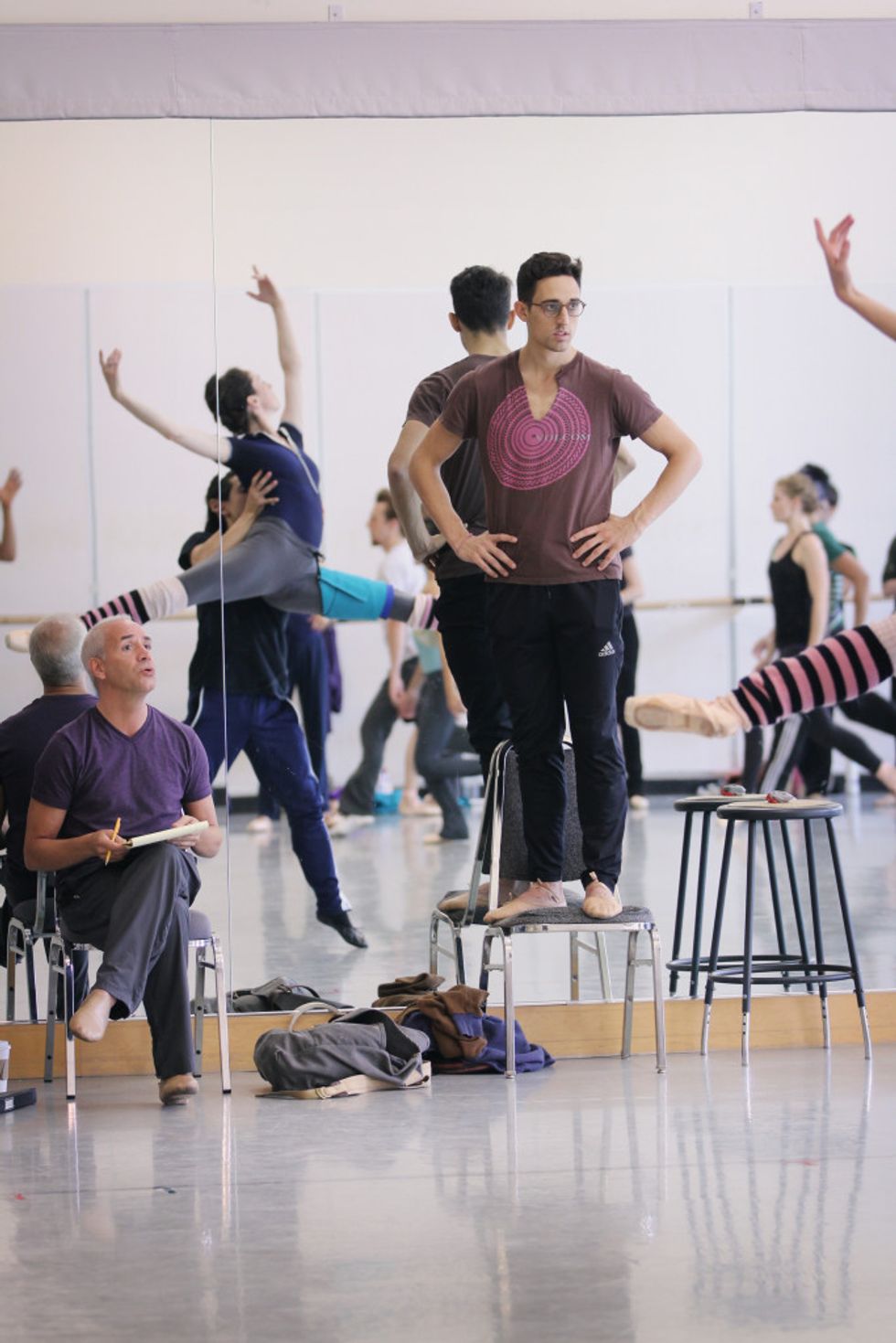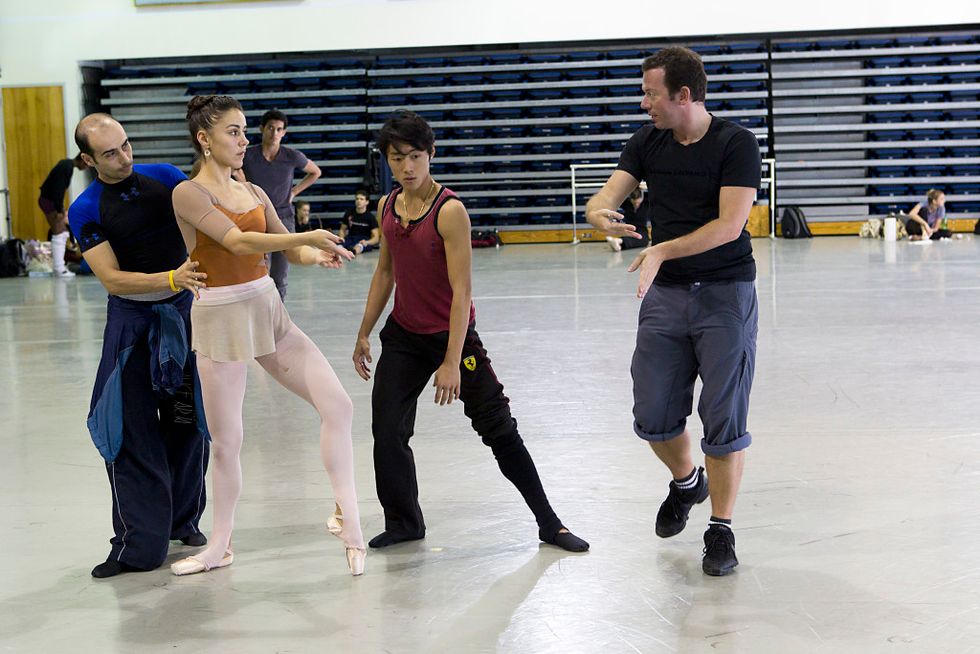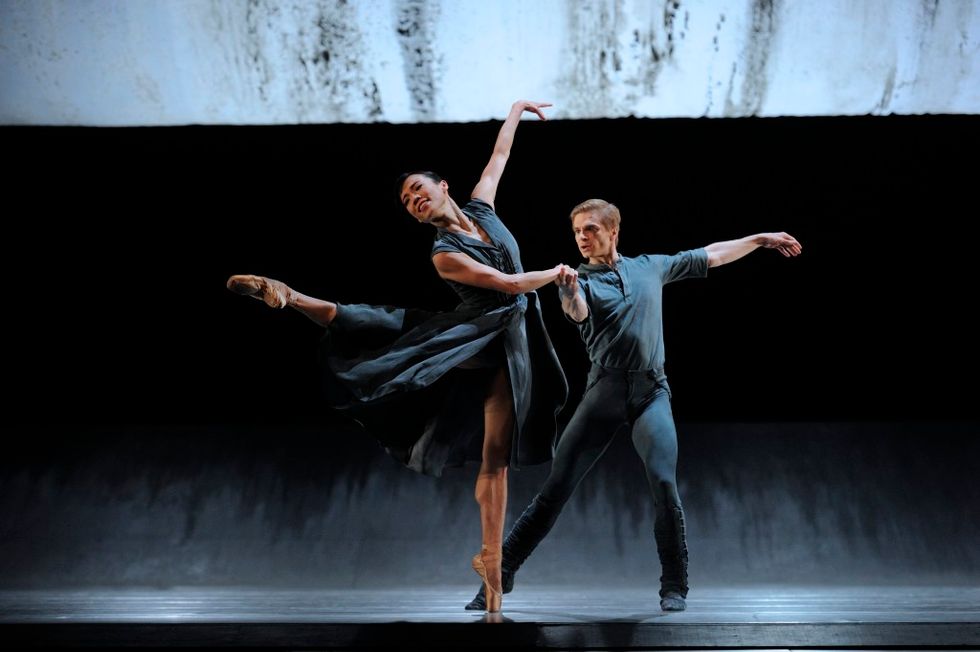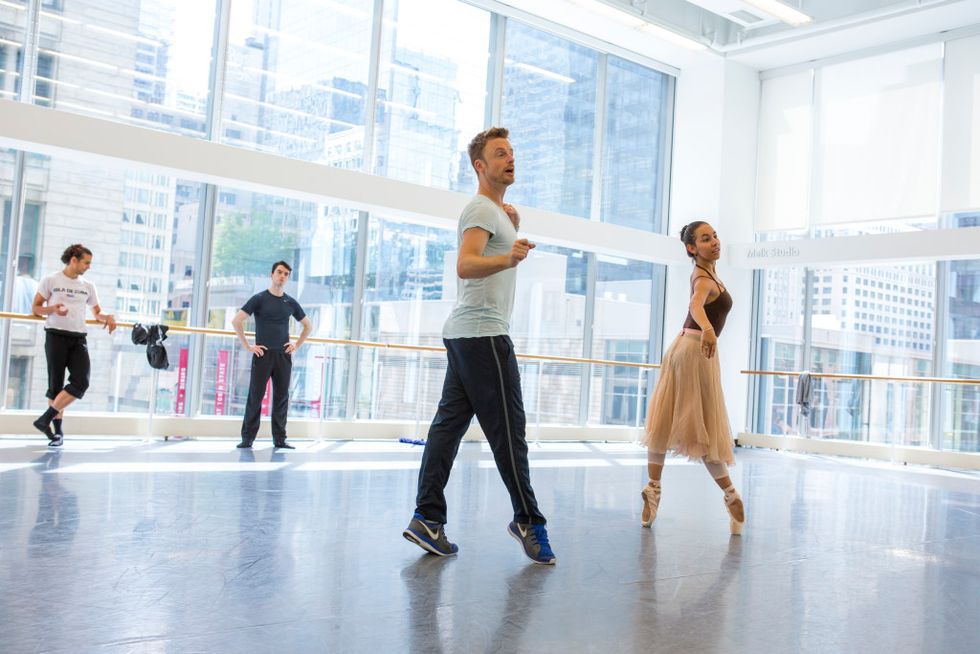Ballet's Boys Club
They’re everywhere.
This season, Royal Ballet artistic associate Christopher Wheeldon will premiere a new work for The Royal in February as part of a Wheeldon triple bill, before the company reprises his much-acclaimed The Winter’s Tale (which was also performed in November by the National Ballet of Canada). And in addition to a new ballet for New York City Ballet and a new Nutcracker for the Joffrey Ballet in December 2016, Wheeldon’s signed on for stagings of his previous works for seven other international troupes.

PNB is one of three companies to dance Peck’s Year of the Rabbit this season. Photo by Lindsay Thomas, courtesy PNB.
Justin Peck will choreograph two works for NYCB, a new ballet for San Francisco Ballet and stage his Year of the Rabbit for Miami City Ballet, Pacific Northwest Ballet and Dutch National Ballet. Similarly, Wayne McGregor’s and Liam Scarlett’s premieres and previous works will be danced from Paris to Houston to San Francisco. And it’s no surprise that Alexei Ratmansky will continue his global ubiquity, especially in the narrative-ballet department.
All five men are wonderfully accomplished choreographers. Wheeldon and Peck instinctively shape ensembles with master craftsmanship and musicality. Scarlett and McGregor display a deft contemporary edge that appeals to young audiences. And Ratmansky brings heart and soul to the stage. Why wouldn’t any company jump at the chance to work with this millennium’s best?
While some may decry the death of ballet, this burst of creative output and shared goodwill has others heralding a new golden age, a cornucopia of choreographic plenty. But are companies oversaturating the market with these named choreographers, and making ballet too safe?
Truthfully, hot-property choreographers have always existed. William Forsythe, Jirí Kylián, Twyla Tharp, Benjamin Millepied and Nacho Duato have all had their Warholian 15 minutes—or longer. But this gang is different. All are resident or affiliated artists with ties to major traditional big-budget companies: The Royal, NYCB and American Ballet Theatre. Their prestige is both institutionally sanctioned and marketed by corporate teams. The widespread presence of these pedigreed men reflects the merchandising of ballet that can happen in a nanosecond. The way companies now cyber-network allows them to easily communicate and share information, as well as to determine which choreographic offer-ings they like via a YouTube clip. And the licensing and dissemination of ballets has emerged with impressive sophistication.
Naturally, with globalization, there are some significant positives. High-quality choreography can be imported almost anywhere. Dancers get to stretch their technical and stylistic chops working with world-class artists. Companies can share productions, particularly expensive full-length ballets, making the process more cost-efficient.
With the pressure to sell out theaters, ballet companies turn to respected names, similar to the way Broadway shows now bank on star actors to guarantee a box-office bonanza. The troubling erosion of ballet audiences can be mitigated by marketing a sexy, young choreographic prodigy. And the companies, choreographers and dancers tweet, Instagram and Facebook their experiences.
Of course, with all this inevitably comes “branding”: a word that makes some salivate and others groan. A choreographer these days is often a traded commodity, and, as it seems, part of a programming formula, in which a good season starts with a modernized classic by Ratmansky and ends with a wild work by McGregor. Franchising is here, in what Mark Morris has accurately called “the ballet industry.” Will this monopolization of choreography make the biggest, richest companies the Apples and Amazons of the ballet industry?
And in the act of franchising, what is lost? For one, companies need an original voice to claim artistic distinction. In the previous century, you could absolutely discern the Joffrey Ballet or ABT from NYCB or The Royal Ballet in terms of style and repertoire. The Royal Ballet demonstrated the precision, musicality and dramatic integrity of Frederick Ashton, Kenneth MacMillan and Ninette de Valois. ABT upheld the theatricality of Antony Tudor and Agnes de Mille. NYCB boasted the neoclassicism and musicality of George Balanchine and Jerome Robbins. Today, when so many troupes dance Year of the Rabbit, can we detect the heart of a company and the uniqueness of its dancers in such a shared context? Maybe yes, maybe no.

Ratmansky at MCB. Photo by Daniel Azoulay, courtesy MCB.
In the best of all possible worlds, today’s amazing dancers can absorb and process 10 different styles with acumen. But the reality of choreographic globalization can unfortunately lead to jeopardizing a company’s artistic spirit and style. In worst-case scenarios, a bland homogeneity of tenor and approach ensues. Outsourcing of talent can also preclude the local nurturing of artists who are homegrown and perhaps best know and appreciate the skills of their native city’s dancers.
That latter downside in particular leads to the most troubling aspects of the omnipresence of the pack: the striking lack of diversity. There are no women or people of color in this boys club of choreographers, and few among the primarily male directors. Chris knows Peter and Peter knows Justin and Justin knows Benjamin and so on. Doesn’t that skew the direction away from a desired goal for more multiculturalism and outreach in the ballet world?
There are exceptions. For example, PNB had a November program called Emergence, featuring contemporary works by prominent female choreographers Jessica Lang and Crystal Pite. In April, English National Ballet will present She Said, a triple bill dedicated to female choreography with world premieres by Aszure Barton, Annabelle Lopez Ochoa and Yabin Wang. And Boston Ballet’s 2015–16 season doesn’t include any of the voguish quintet in its programming. That doesn’t necessarily mean that the results will be better—just that they are presenting an alternative. And there are smaller companies, exemplified by Sarasota Ballet’s dedication to Ashton’s legacy and Ballet Memphis’ commitment to the community’s cultural flavor and impressive diversity, which offer refreshing options.
I look forward to seeing what these gifted men will produce in the future. They have already changed the face of ballet in this century and have whipped up masterpieces that inform us, as great art always does, about ourselves in today’s world: Think of Wheeldon’s Polyphonia, McGregor’s Chroma and Ratmansky’s Concerto DSCH. The Winter’s Tale by Wheeldon might rank as the finest new story ballet in decades. But perhaps ballet directors need to step back, take a look at other talent that exists and strive to present ballets that speak to their audiences and truly represent their locale, their dancers and the singularity of a director’s vision.
The Lineup for 2015–16
Wayne McGregor
• Raven Girl: The Royal Ballet (Oct. 2015)
• Chroma: Pennsylvania Ballet (Oct. 2015)
• Dyad 1929: Houston Ballet (March 2016)
• Infra: Mariinsky Ballet (May 2016)
• Commissions: Paris Opéra Ballet (Dec. 2015), The Royal (May/June 2016)
Justin Peck
• Rodeo: Four Dance Episodes: New York City Ballet (Oct. 2015)
• Year of the Rabbit: Miami City Ballet (Feb. 2016), Pacific Northwest Ballet (March 2016), Dutch National Ballet (June 2016)
• Paz de la Jolla: NYCB (Feb. 2016)
• Chutes and Ladders: PA Ballet (Feb. 2016)
• In Creases: POB (March/April 2016)
• Everywhere We Go: NYCB (April 2016)
• Belles-Lettres: NYCB (May 2016)
• Commissions: NYCB (Sept./Oct. 2015), NYCB (Feb./April/May 2016), San Francisco Ballet (April 2016), POB (July 2016)
Alexei Ratmansky
• The Sleeping Beauty: Teatro alla Scala (Sept./Oct. 2015), American Ballet Theatre (Jan./June 2016)
• Russian Seasons: Bolshoi Ballet (Oct. 2015)
• Piano Concerto #1: ABT (Oct./Nov. 2015)
• Lost Illusions: Bolshoi (Oct./Nov. 2015)
• Romeo and Juliet: National Ballet of Canada (Nov./Dec. 2015, March 2016)
• Cinderella: Mariinsky (Dec. 2015, March/May 2016), The Australian Ballet (Feb. 2016)
• Seven Sonatas: POB (March/April 2016), SFB (April 2016), ABT (May 2016)
• Concerto DSCH: Mariinsky (March 2016), NYCB (May 2016)

SFB’s Frances Chung and Gennadi Nedvigin in Scarlett’s Hummingbird.
Photo by Erik Tomasson, courtesy SFB
.
• Pictures at an Exhibition: NYCB (April 2016)
• Shostakovich Trilogy: ABT (May 2016)
• Firebird: ABT (May/July 2016)
• The Golden Cockerel: ABT (June 2016)
• Commissions: ABT (May 2016)
Liam Scarlett
• A Midsummer Night’s Dream: Royal New Zealand Ballet (Aug./Sept. 2015)
• No Man’s Land: English National Ballet (Sept./Nov. 2015)
• Viscera: The Royal (Oct./Nov. 2015), MCB (Oct./Nov. 2015)
• Asphodel Meadows: PA Ballet (May 2016)
• Commissions: SFB (Jan./Feb. 2016), Frankenstein at The Royal (May 2016)
Christopher Wheeldon
• Fool’s Paradise: Joffrey Ballet (Sept. 2015)
• Tide Harmonic: PNB (Sept./Oct. 2015)
• DGV: PA Ballet (Oct. 2015)

Wheeldon’s Rush at Houston Ballet. Photo by Amitava Sarkar, courtesy Houston Ballet.
• The Winter’s Tale: NBoC (Nov. 2015), The Royal (April/June 2016)
• Polyphonia: POB (Dec. 2015)
• Continuum: SFB (Jan./Feb. 2016)
• This Bitter Earth: NYCB (Feb. 2016)
• For Four: PA Ballet (Feb. 2016)
• After the Rain: The Royal (Feb./March 2016)
• Within the Golden Hour: The Royal (Feb./March, May/June 2016)
• Estancia: NYCB (Feb./April 2016)
• Rush: SFB (April 2016)
*Scheduled repertory as of press time




